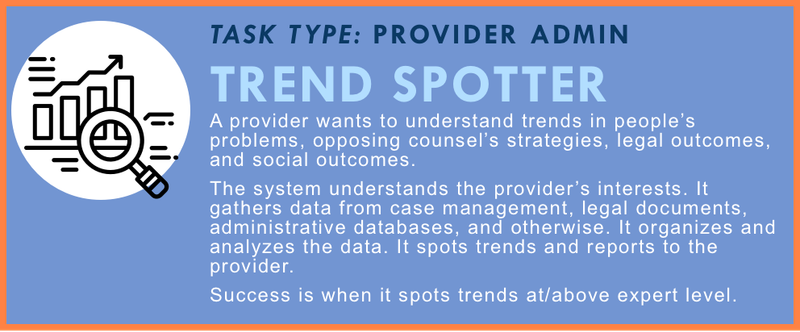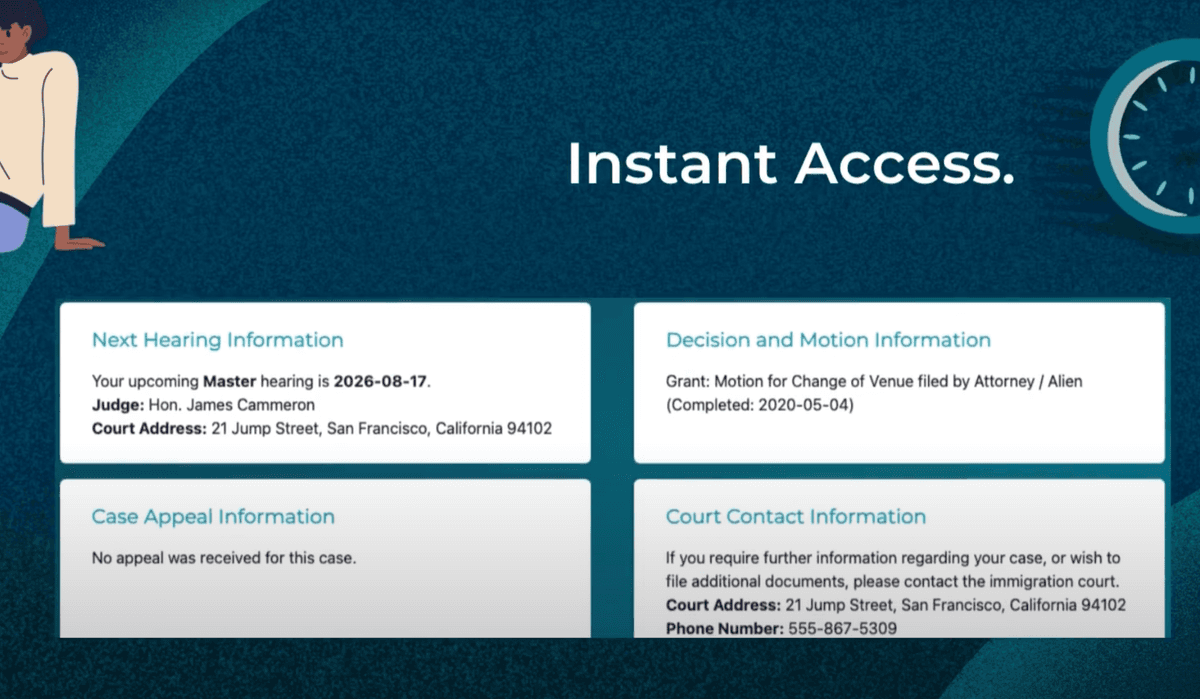Trends Spotter

Help providers spot trends in client needs, legal strategies, and outcomes by analyzing data across systems and delivering actionable insights.
Task Description
Legal help organizations need more than individual case records—they need to understand what’s happening across their caseloads, what patterns are emerging, and how to improve strategy, operations, and policy advocacy. This includes trends in who is seeking help, what types of legal problems are rising, how opposing parties are behaving, and what outcomes clients are experiencing—both legal and social.
This task involves a system that acts as an intelligent insight and trend analysis engine. It connects to existing data sources such as case management systems, legal documents, hearing outcomes, and external administrative databases (e.g., housing records, benefits enrollment, court calendars). The system cleans and structures the data, identifies patterns, and highlights trends over time—such as increasing evictions in a certain neighborhood, a shift in opposing counsel tactics, or disparities in outcomes by race, language, or disability.
It doesn’t just show raw data—it interprets it through the lens of the provider’s goals and interests. The system surfaces insights like “clients receiving only brief services are twice as likely to face judgment,” or “a spike in benefit denials began after policy X changed.” It can tailor dashboards and reports by role (e.g., attorney vs. executive director vs. policy advocate) and provide alerts when a new trend emerges.
This tool is particularly powerful for organizations doing systems change work, evaluating their service models, or seeking to influence policy with data. It strengthens internal learning, operational improvement, and advocacy by providing insights that previously took months—or weren’t possible to detect at all.
Success means the provider receives high-quality, tailored trend insights that match or exceed what an experienced analyst could identify—faster, deeper, and more consistently.
Tools here could:
- Detect emerging legal issues or rising demand (e.g., sudden spike in eviction guide traffic)
- Identify gaps in content or services
- Recommend new guides, forms, partnerships, or system-level reforms
This is essentially an early warning system and strategic planning tool built on behavioral and service delivery data.
Primary audiences: Statewide website admins, legal aid leadership, policy analysts, courts, funders
Quantitative Summary of Stakeholder Feedback
- Average Value Score: 4.00 (Moderate-high)
- Collaboration Interest: 3.79 (Moderate-high)
Stakeholders see this as useful, especially for back-end strategy and content planning. While not as urgent as direct user-facing tools, it’s still ranked well across both dimensions.
Existing Projects
Several foundations exist, but not yet AI-augmented:
- Google Analytics 4 (GA4) implementations across many sites
- Manual tracking of top search terms, page hits, and drop-off rates
- Some court and legal aid systems use dashboards, but not AI-driven insights
- LegalServer and other CRMs collect raw intake data that could fuel trend analysis
“We have pretty rich GA4 data, but no unified way to turn that into trend alerts or strategic reports.”
“Some products already have tagging and filtering built in—we just don’t have a layer of AI summarizing it.”
Stakeholder Commentary
- Broad agreement that this would be a “nice-to-have” tool with strategic value
- Some concern that AI might generate false positives or distract from deep root-cause analysis
- Requests for standardized dashboards shared across organizations, not siloed tools
“This won’t help a user directly, but it might help 10,000 users if we build the right new guide in time.”
“A standardized trend analysis tool that everyone uses could help the entire network stay current.”
How to Measure Quality?
📥 Data Coverage and Integration
- Pulls data from multiple systems: case management, court records, outcomes tracking, intake surveys, etc.
- Supports both structured (e.g., dropdowns, dates) and unstructured data (e.g., notes, filings)
- Maintains confidentiality and complies with data-sharing policies
🧠 Trend Detection Accuracy
- Identifies meaningful shifts in volume, issue type, demographics, or service level
- Spots patterns across multiple data points (e.g., legal outcome + social outcome)
- Surfaces anomalies or correlations without prompting
📊 Interpretability and Actionability
- Provides clear, plain-language explanations of trends (e.g., “Brief services increased 25% in Q2”)
- Highlights possible causes and consequences
- Suggests questions or actions based on the findings
⚖️ Equity and Impact Analysis
- Supports breakdowns by race, language, disability, income, and other equity markers
- Detects disparities in service levels or outcomes
- Flags recurring patterns that may signal bias or systemic barriers
📈 Provider Customization and Alerts
- Tailors reports to the organization’s goals, programs, or funder requirements
- Allows teams to set focus areas or KPIs (e.g., early resolution, tenant success rate)
- Sends alerts when new trends or thresholds are detected
🔍 Expert Benchmarking and Validation
- Trends and conclusions match or exceed those surfaced through human expert review
- Provides justifications and links to source data for audit or review
- Supports iterative refinement and inclusion of expert review feedback
Stakeholders offered clear ideas on how to know if a tool is doing a good job at this task:
- Correlation to real-world shifts (e.g., does spike in search traffic match new law or crisis?)
- Timeliness: Can it alert staff quickly enough to respond?
- Actionability: Do the insights lead to new guides or improvements?
“Verify identified trends by comparing to grant reports or field interviews. Are we seeing what people are living?”
“The tool should say: ‘Your tenants guide is trending. Add something about AB1482 by next week.’”
